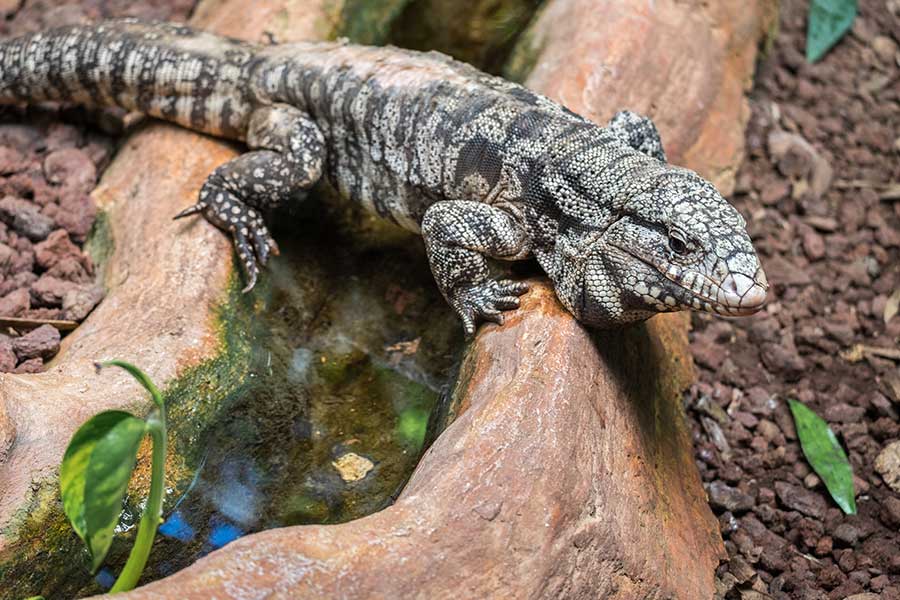So, you’re considering bringing a tegu into your life? That’s fantastic! But before you take the plunge into reptile parenthood, let’s talk about the essential groundwork needed for a harmonious life with your scaly companion.
Understanding the Tegu’s Habitat: Building Their Home
Imagine creating a kingdom for your tegu. Space is key – these creatures love their freedom. Building or setting up a spacious enclosure that mimics their natural habitat is crucial. Here are the things you must consider:
1. Size Matters: Aim for a spacious enclosure; these reptiles need ample room to roam. The minimum size for an adult enclosure should be around 8 feet long, 4 feet wide, and 4 feet tall. More space is always appreciated!
2. Material Selection: Opt for sturdy materials for the enclosure. Plywood, melamine, or PVC are suitable choices. Avoid glass enclosures as they can stress out tegus and don’t retain heat well.
3. Substrate Selection: Choose a substrate that retains moisture but isn’t prone to molding. Options like cypress mulch, coconut coir, or a mix of soil and play sand work well. Depth should be around 6-8 inches.
4. Temperature Gradient: These reptiles need a warm basking area (around 100-110°F) and a cooler side (around 75-85°F) in their enclosure. Heat lamps or ceramic heat emitters are great for providing the necessary temperature gradient.
5. Hiding Spots: Incorporate various hiding spots and shelters. Half logs, rock caves, or custom-built hide boxes provide security and help reduce stress.
6. Water Feature: Tegus enjoy soaking, so a shallow water dish or a small pool area within the enclosure is ideal. Ensure it’s easily accessible and cleaned regularly.
7. Climbing Accessories: They are semi-arboreal, so include climbing opportunities like branches, logs, or platforms for them to explore vertically. Furthermore, add plants (real or artificial) to provide a natural feel. Tegus benefits from an enriched environment for mental stimulation and exercise.
Meal Planning for a Voracious Eater: Tegu’s Diet
Tegus are big-time foodies! They eat a variety of things, from fruits and veggies to insects and small mammals. Research and prepare a diverse and nutritious diet for them and the necessities such as proportions, foods to avoid, hydration, supplements and transitioning foods as it is vital for their well-being.
Cracking the Tegu Code: Understanding Behavior
These scaly critters have personalities too. They are known for their intelligence and curious nature, making them interesting companions. But just like any pet, they have their quirks. Understanding their behaviors, from basking rituals to their unique stubbornness, sets the stage for a solid relationship.
Healthcare Essentials: Finding the Right Vet
Finding the right vet for your new pet lizard is crucial for their well-being and long-term health. Tegus, being reptiles, have specific needs that not all veterinarians are familiar with. A vet experienced in reptile care understands the nuances of tegu health, behavior, and potential health issues unique to these creatures. They can provide tailored advice on diet, habitat, and overall care, offering preventive measures to maintain your tegu’s health.
In case of any health concerns or emergencies, a reptile-savvy vet can provide prompt and accurate diagnoses, ensuring appropriate treatment and improving the chances of a positive outcome. Establishing a relationship with a knowledgeable vet early on allows for proactive healthcare and a better quality of life for your pet reptile.
Key Takeaways
Preparing for a tegu involves setting up a spacious habitat, planning a diverse diet, understanding their behavior, finding a reptile-savvy vet, and meticulously going through your pre-tegu checklist. This groundwork not only ensures a comfortable environment for your scaly friend but also paves the way for a smooth transition into pet ownership, setting the stage for a rewarding and fulfilling relationship between you and your tegu companion.
